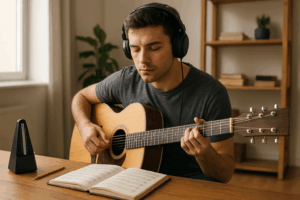Mastering rhythm and timing is one of the most fundamental skills for any musician. If you’re just starting out, developing a good sense of rhythm and timing will set the foundation for everything else in your musical journey. It’s not just about hitting the right notes — it’s about playing them at the right moment.
Why Rhythm and Timing Matter in Music
Rhythm is the heartbeat of music. It’s what keeps songs moving and musicians playing together in harmony. Without it, even the best notes can sound off.
Solid timing helps you:
- Play with other musicians smoothly.
- Stay consistent from start to finish.
- Build confidence in your musical performance.
- Understand and enjoy music more deeply.
Think of a band or orchestra: when everyone is in time, the sound is tight and powerful. When even one person is off, the music suffers. That’s the power of rhythm.
What Is Rhythm? Understanding the Basics
Rhythm refers to the pattern of sounds and silences in music. It’s created by:
- Beats: The steady pulse you tap your foot to.
- Tempo: The speed of the beat (slow, medium, or fast).
- Note duration: How long or short each sound is played.
- Patterns: Repeating combinations of notes and rests.
Rhythm is present in every style of music, from classical to hip-hop. It’s what makes you want to move, nod your head, or dance.
Timing: The Art of Playing in Sync
Timing is your ability to stay aligned with the beat. It’s different from rhythm, but they work hand in hand. Good timing means:
- You don’t rush or drag notes.
- You come in at the right moment.
- You stay in sync with others.
- You sound natural and musical, not robotic or chaotic.
Think of timing as your internal clock. The better it’s trained, the more in control you feel when playing.
Common Rhythmic Patterns Beginners Should Know
Start by learning basic time signatures and their feel:
- 4/4: Most common in pop and rock (counted as “1-2-3-4”).
- 3/4: Found in waltzes and classical music (“1-2-3”).
- 6/8: Often in ballads and slow grooves (“1-2-3-4-5-6”).
Practice clapping these patterns and speaking them out loud to internalize their feel.
Also try simple rhythm combinations:
- Quarter notes (1 note per beat)
- Eighth notes (2 notes per beat)
- Sixteenth notes (4 notes per beat)
- Syncopation (emphasizing off-beats)
How to Practice Rhythm Effectively
You don’t need an instrument to practice rhythm. Try these methods:
- Clap or tap rhythms along with songs.
- Count out loud while playing.
- Use a drum pad or even a table to practice patterns.
- Break down rhythms into small, repeatable sections.
- Record yourself and listen back to analyze your consistency.
Set small rhythm goals like “clap a steady 4/4 beat for 60 seconds” or “play 8 bars of eighth notes without speeding up.”
Metronome Magic: Why You Should Use One
A metronome is a vital tool for beginners. It gives you a steady beat to follow and helps develop precise timing.
Tips for using a metronome:
- Start slow. Accuracy matters more than speed.
- Use it in short sessions so you don’t burn out.
- Try accenting different beats to understand emphasis.
- Play along with backing tracks that include a click.
- Use visual metronomes or apps that make rhythm more interactive.
Over time, the metronome trains your internal timing so you can play steadily even without it.
Developing Inner Timing Without Tools
Eventually, you want to rely less on the metronome and more on your sense of timing. Here’s how:
- Sing or hum rhythms before playing them.
- Walk or move to a beat while listening to music.
- Record yourself and listen critically.
- Visualize the beat while playing.
- Play with others: Group practice challenges your ability to stay in sync naturally.
This helps you build a natural, reliable feel for time and stay grounded when performing.
Exercises to Sharpen Your Rhythm Skills
Here are some fun, beginner-friendly rhythm exercises:
- Clap along to your favorite songs and try to stay in time.
- Tap quarter, eighth, and sixteenth notes with your hands or feet.
- Play along with rhythmic apps like Rhythm Trainer.
- Switch between tempos to challenge your adaptability.
- Practice call-and-response with a teacher or a backing track.
Try creating your own rhythmic phrases and repeating them until they feel natural.
How to Apply Rhythm in Real Songs
Once you’ve practiced rhythm basics, start applying them in actual songs:
- Choose a simple song and identify its time signature.
- Clap or tap through it before playing.
- Play along slowly with a recording.
- Try singing while keeping time with your hands or feet.
- Gradually increase tempo while maintaining accuracy.
Application reinforces learning and makes your practice more enjoyable.
Mistakes to Avoid When Practicing Rhythm
Even experienced musicians struggle with rhythm from time to time. Here are common pitfalls:
- Speeding up unconsciously as the song progresses.
- Ignoring rests and focusing only on the notes.
- Over-reliance on the metronome without listening actively.
- Not counting out loud, especially during tricky sections.
- Skipping rhythm exercises in favor of melodic ones.
Awareness is the first step to correcting these habits. Be patient and honest with your rhythm practice.
Final Thoughts: Groove Comes with Practice
Understanding and mastering rhythm and timing takes time, but it’s one of the most rewarding parts of learning music. It improves your playing, makes collaboration easier, and deepens your musical intuition.
Be patient. Be consistent. And most of all, enjoy the groove. The more you play with rhythm, the more rhythm will play with you!
Rhythm is a lifelong journey. Start now, and you’ll build a strong musical foundation that will support every note you ever play.




